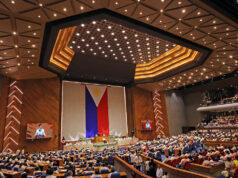THE Philippines made headway in providing adequate water, sanitation, and hygiene (WASH) facilities in 2019, according to the Philippine Statistics Authority’s (PSA) Annual Poverty Indicators Survey (APIS).
The 2019 APIS indicates that 93.7% of 25.310 million families have access to basic-service level handwashing facilities or handwashing facilities on-premises with soap and water last year, up from 76.9% in 2017.
Those with “limited” access, defined as having a handwashing facility on-premises without soap and/or water, fell to 4.2% from 8.4% previously.
The PSA noted the survey’s questions related to WASH were primarily intended to monitor the achievement of Sustainable Development Goals (SDGs), particularly SDG No. 6, which aims to “ensure availability and sustainable management of water and sanitation for all.”
Around 69.9% of families have a handwashing facility in the form of a fixed facility (sinks or taps) in the dwelling unit in 2019, up from 51.7% in 2017. Meanwhile, those with “mobile objects” such as buckets and fixed facilities in yards and plots account for 13.1% (from 16.1%) and 10.7% of households (from 13.1%), respectively.
Those with no access to handwashing facilities account for 2.8% of all families, down from 13.9% in 2017. In terms of the availability of soap, 82.9% of families have a bar or liquid soap, 43% have detergent soap, while 1% have ”other,” and 0.3% say they use ash, soil, or sand.
In urban areas, 93.9% of families had access to handwashing facilities, compared with 91.8% in rural areas.
Families in the Bangsamoro Autonomous Region in Muslim Mindanao (BARMM) had the highest share of families with handwashing facilities with limited service and those without such facilities in 2019 at 15.1% and 14.1%, respectively. The share of families with limited services in the region last year rose from 12.4% in 2017, those without handwashing facilities significantly declined from 55.2% previously.
DRINKING WATER
The survey showed that around 96% of 25.310 million families have access to an improved source of drinking water. This compared to around 94% of 24.354 million families in the previous survey.
The top three sources of drinking water were water refilling stations from an improved source, which accounted for 45.2% (up from 37.7%) of the total, followed by piped water into dwellings at 20.4% (from 20.3%), and tube wells or boreholes at 9.7% (from 12%).
Of those families surveyed, 85.2% reported that water was always sufficient. For others, it was either that water was “not available from source” (11.1%), the water source was not “accessible” (1.3%), or that water was “too expensive” (0.4%).
In addition, four in every five families — or 78.8% — did not treat their drinking water to ensure it is safe. This was higher than 76.6% reported previously.
SANITATION
The report surveyed for sanitation facilities, defined by the PSA as those “designed to hygienically separate excreta from human contact.”
In 2019, 81.6% had “basic service-level sanitation” or the use of improved facilities that are not shared with other households, significantly higher than the 73.7% in 2017.
The proportion of families using basic sanitation level services ranged from 32.7% in the BARMM to 90.2% in the Cagayan Valley.
University of Asia and the Pacific (UA&P) School of Economics Senior Economist Cid L. Terosa called the improvements made in WASH “remarkable” and beyond expectations.
“The availability of handwashing, drinking water, and sanitation facilities is correlated with better health conditions… Given the emphasis on handwashing and personal hygiene because of the pandemic, the results seem to show that the government has laid the groundwork for people to assiduously follow health protocols,” Mr. Terosa said in an e-mail.
“Given these results, the government can focus more on conditions for disease transmission that are not related to water and sanitation facilities,” he added.
In a separate e-mail, Asian Institute of Management Economist and Adjunct Faculty, John Paolo R. Rivera said that while these improvements were expected given rising incomes and the implementation of the government’s poverty alleviation programs, much work remains to be done in making these gains sustainable.
“These improvements, particularly in access to water and sanitation, helped in protecting households against coronavirus to some extent as frequent handwashing and good sanitation are key to preventing the spread of the virus. However, it is necessary but not sufficient,” Mr. Rivera said, noting the pandemic has eroded the improvements in reducing poverty due to losses in jobs and incomes.
“Given the impacts of the pandemic, the poverty situation will worsen which will make it more challenging for households to access not only water and sanitation but also other basic necessities such as food, clothing, housing, healthcare. The social amelioration program can only do so much and requires timely and continuous funding to make it sustainable. Otherwise, any gains we made in the battle against poverty will be eroded,” Mr. Rivera explained.
UA&P’s Mr. Terosa said the Philippines will likely show better results in the WASH indicators in future surveys, provided that the country can recover quickly from the economic slump brought about by the pandemic.
“Although development indicators will clearly worsen this year because of the pandemic, my long-term view as regards water and sanitation infrastructure is positive because the country has seemingly achieved sufficient critical mass,” Mr. Terosa said.
“Also, the improvement of water and sanitation facilities can advance the alleviation of poverty in the future since the creation of a healthy society and nation is a prerequisite for greater labor productivity and better human capital.” — Jobo E. Hernandez



